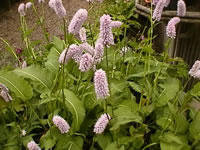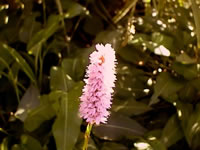How to Grow and Care for Knotweed Plants
Persicaria bistorta
          
Knotweed (or Bistort) plants are low maintenance, quick growing, semi-evergreen perennials with bright green,
4"-8" lance shaped leaves. They grow 2- 2½ ft. tall, and spread to form 3 foot wide mounds.
Once classified as Polygonum bistorta, Knotweed plants produce 3"-6", bottlebrush-like spikes of tiny,
pink flowers on leafless stems that rise above the foliage from late spring into early fall. Knotweed is an excellent
ground cover plant, especially when planted along the edge of a pond, a stream or in boggy areas.
|
 |
Knotweeds are rabbit and deer resistant plants that will attract butterflies and bees to your garden.
They make excellent cut flower bouquets.
Growing Requirements for Knotweed Plants
Persicaria bistorta plants are hardy in USDA zones 4-9.
They are very easy to care for plants that can be grown in full sun or light shade,
except in hot summer regions where they should only be grown in partial shade.
Knotweed should be planted in fairly rich, constantly moist but well-drained soil
that has been supplemented with compost at planting time.
Water regularly and thoroughly!
Lack of sufficient water or will result in a dismal flower display. |
|
Remove spent flower spikes regularly to encourage your Knotweed plants to continue blooming.
Propagating Bistort Plants and Growing them from Seed
Established clumps of Knotweed can be easily divided for propagation purposes or to contain growth, in early spring or in the fall.
Seeds can be sown directly in the garden in late summer or in the spring, after all danger of frost has passed.
Sow seeds indoors onto a moistened growing medium in early spring, barely covering them with fine soil.
Keep the growing mix evenly moist throughout the entire process.
Maintain a temperature in the growing medium of 65°-75° until germination, which takes 3-4 weeks. |
|
Knotweed
Persicaria bistorta
 |
 |
|
|
|
|
Search The Garden Helper:



